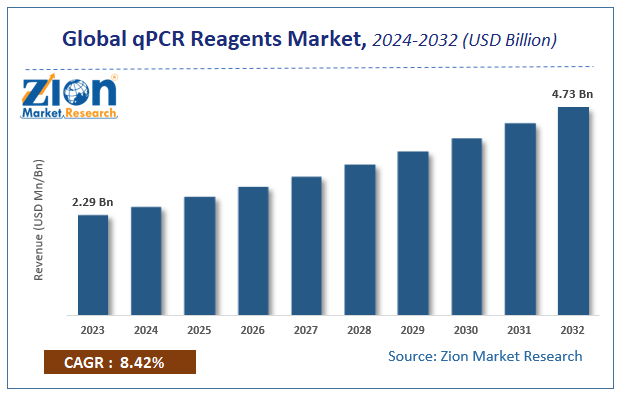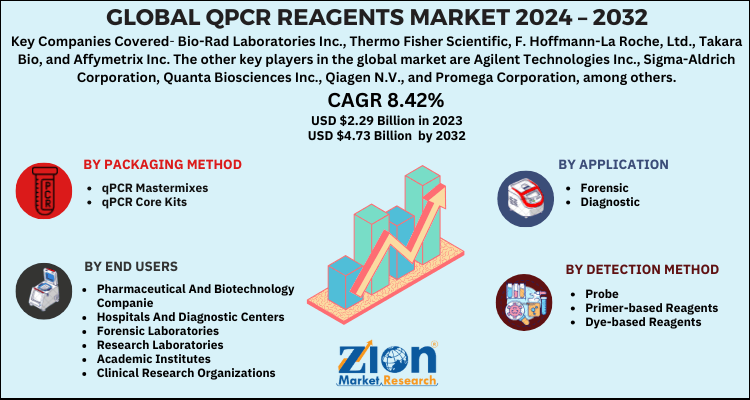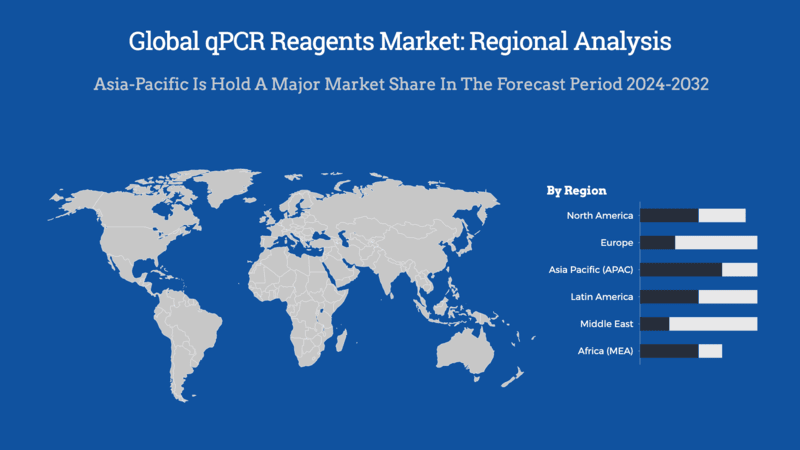qPCR Reagents Market Size, Share, Trends, Growth and Forecast 2032

qPCR Reagents Market: By End-User (Pharmaceutical & Biotechnology Companies, Hospitals & Diagnostic Centers, Forensic Laboratories, Research Laboratories & Academic Institutes, and Clinical Research Organizations), By Packing Method (qPCR Mastermixes and qPCR Core Kits), By Application (Research, Forensic, and Diagnostic), and By Detection (Probe & Primer-Based Reagents and Dye-Based Reagents), and By Region: Global Industry Perspective, Comprehensive Analysis and Forecast, 2024 - 2032
| Market Size in 2023 | Market Forecast in 2032 | CAGR (in %) | Base Year |
|---|---|---|---|
| USD 2.29 Billion | USD 4.73 Billion | 8.42% | 2023 |
Global qPCR Reagents Market: Insights
According to a report from Zion Market Research, the global qPCR Reagents Market was valued at USD 2.29 Billion in 2023 and is projected to hit USD 4.73 Billion by 2032, with a compound annual growth rate (CAGR) of 8.42% during the forecast period 2024-2032. This report explores market strengths, weakness, opportunities, and threats. It also provides valuable insights into the market's growth drivers, challenges, and the future prospects that may emerge in the qPCR Reagents industry over the next decade.
Global qPCR Reagents Market: Overview
A qPCR, also known as real-time polymerase chain reaction, is a lab method of molecular biology-dependent on the polymerase chain reaction. qPCR screens the magnification of the specific DNA segment during the polymerase chain reaction, that is, in real time, contrary to the conventional polymerase chain reaction that screen at the end of the process. qPCR can be used in two different variations, namely, semi-quantitative real-time polymerase chain reaction and quantitative real-time polymerase chain reaction. Owing to the increasing demand for the qPCR reagents, the global market is expected to grow in the near future.
Global qPCR Reagents Market: Growth Factors
The prominent factors propelling the growth of the global qPCR reagents market include increasing patient population for genetic disorders and infectious diseases, the rise in aged population, and advancement in technologies in the life sciences domain. The other major factors boosting the growth of the global market are increasing private and public funds, grants, and investments for studies based on PCR and the successful achievement of the human genome project. However, technical restrictions related to qPCR may hinder the growth of the global qPCR reagents market.
Key Insights
- As per the analysis shared by our research analyst, the global qPCR Reagents Market is estimated to grow annually at a CAGR of around 8.42% over the forecast period (2024-2032).
- In terms of revenue, the global qPCR Reagents Market size was valued at around USD 2.29 Billion in 2023 and is projected to reach USD 4.73 Billion by 2032.
- Based on the end-user, the Hospitals and Diagnostic Centers this segment holds the largest market share, driven by the critical role of qPCR in diagnosing infectious diseases, genetic disorders, and cancer within clinical settings.
- Based on the packaging method, the qPCR Core Kits these kits dominate due to their affordability compared to qPCR Mastermixes and the flexibility they offer researchers in developing independent reaction protocols.
- Based on the application, the Diagnostic Applications this segment leads the market, as qPCR is extensively utilized for detecting infectious diseases, genetic disorders, and cancer, emphasizing its importance in clinical diagnostics.
- Based on the detection method, the Probe and Primer-Based Reagents these reagents are preferred for their superior specificity and sensitivity, making them ideal for applications requiring precise quantification, such as viral load monitoring and cancer biomarker detection.
- Based on the region, the North America this region holds the largest market share, attributed to the rising prevalence of chronic diseases, robust healthcare infrastructure, and the presence of key industry players.
qPCR Reagents Market: Dynamics
Key Growth Drivers
The qPCR (quantitative Polymerase Chain Reaction) reagents market is primarily driven by the increasing prevalence of infectious diseases and genetic disorders, which has heightened the demand for accurate and rapid diagnostic solutions. Technological advancements in qPCR systems, including the development of high-throughput and multiplex qPCR assays, have further accelerated market growth. The rising adoption of qPCR in clinical diagnostics, research applications, and forensic investigations also contributes significantly to the market's expansion. Additionally, the growing focus on personalized medicine and the increasing use of qPCR in pharmaceutical and biotechnology companies for drug discovery and development further fuel the demand for qPCR reagents.
Restraints
Despite its growth potential, the qPCR reagents market faces challenges such as the high cost of qPCR instruments and reagents, which may hinder adoption in resource-limited settings. The requirement for specialized laboratory infrastructure and skilled personnel to perform qPCR testing can also limit market expansion, particularly in developing regions. Additionally, the presence of alternative technologies, such as digital PCR (dPCR) and next-generation sequencing (NGS), may reduce the reliance on qPCR in some applications. Strict regulatory requirements for the approval of qPCR assays and reagents further pose a challenge for market players.
Opportunities
Emerging applications of qPCR in areas such as liquid biopsy, cancer diagnostics, and infectious disease monitoring offer significant growth opportunities for the qPCR reagents market. The increasing investments in molecular diagnostics and biotechnology research, particularly in developing countries, provide further market expansion prospects. Additionally, the growing demand for point-of-care (POC) testing and rapid diagnostics has led to the development of portable and user-friendly qPCR devices, creating new opportunities for reagent manufacturers. Collaborations between research institutions, diagnostic companies, and pharmaceutical firms are also driving innovation and the introduction of novel qPCR reagent products.
Challenges
One of the primary challenges faced by the qPCR reagents market is the risk of contamination and false results due to improper sample handling and reagent quality issues. Maintaining the stability and shelf life of qPCR reagents, especially during transportation and storage, is another challenge for manufacturers. Moreover, the increasing competition from alternative molecular diagnostic technologies and the need for continuous innovation to meet evolving research and diagnostic demands add to the market's challenges. Limited awareness and inadequate access to advanced molecular diagnostic techniques in certain regions also hinder market penetration.
qPCR Reagents Market: Report Scope
| Report Attributes | Report Details |
|---|---|
| Report Name | qPCR Reagents Market |
| Market Size in 2023 | USD 2.29 Billion |
| Market Forecast in 2032 | USD 4.73 Billion |
| Growth Rate | CAGR of 8.42% |
| Number of Pages | 110 |
| Key Companies Covered | Bio-Rad Laboratories Inc., Thermo Fisher Scientific, F. Hoffmann-La Roche, Ltd., Takara Bio, and Affymetrix Inc. The other key players in the global market are Agilent Technologies Inc., Sigma-Aldrich Corporation, Quanta Biosciences Inc., Qiagen N.V., and Promega Corporation, among others |
| Segments Covered | By End-User, By Packaging Method, By Application, By Detection Method And By Region |
| Regions Covered | North America, Europe, Asia Pacific (APAC), Latin America, Middle East, and Africa (MEA) |
| Base Year | 2023 |
| Historical Year | 2018 to 2022 |
| Forecast Year | 2024 - 2032 |
| Customization Scope | Avail customized purchase options to meet your exact research needs. Request For Customization |
Global qPCR Reagents Market: Segmentation
The global qPCR reagents market can be segmented based on end-user, packaging method, application, detection method, and region. All the segments have been analyzed based on present and future trends and the market is estimated from 2024 to 2032.
The end-user segment of the market is divided into pharmaceutical and biotechnology companies, hospitals and diagnostic centers, forensic laboratories, research laboratories and academic institutes, and clinical research organizations.
The packaging method segment of the global market is classified into qPCR mastermixes and qPCR core kits.
The application segment of the global qPCR reagents market is diversified into research, forensic, and diagnostic.
The detection method segment of the market is sub-segmented into the probe and primer-based reagents and dye-based reagents.
Region-wise, the global market is segregated into North America, Europe, Asia Pacific, Latin America, and Middle East & Africa.
Global qPCR Reagents Market: Regional Analysis
North America is assumed to dominate the global qPCR reagents market in the near. The major factors attributing to the growth of this region are the rise in private and public funding to enlarge the application of qPCR, high acuity of qPCR technologies among the end users, cost reduction in genome sequencing, and constant product enhancements in the area of qPCR reagents. Asia Pacific is also anticipated to grow at a faster pace in the coming period due to growing attempts to boost alertness related to gene-based disease treatment and analysis, rising concentration of global life sciences industries in this region, increasing private and public support to expand new digital PCR technologies, rising cancer study in Japan, and the growth of the genomics market in India.
The quantitative Polymerase Chain Reaction (qPCR) reagents market exhibits significant regional variations, influenced by factors such as healthcare infrastructure, research activities, and technological advancements.
North America
North America leads the qPCR reagents market, primarily due to substantial public and private funding aimed at expanding qPCR applications. The region's advanced healthcare infrastructure and high adoption rates of qPCR technologies among end-users contribute to this dominance. Continuous product enhancements and a focus on cost reduction in genome sequencing further bolster market growth in this region.
Europe
Europe represents a significant portion of the qPCR reagents market, with countries like Germany, France, the UK, Spain, and Italy leading in consumption. The region's proactive approach in identifying and leveraging new growth prospects positions it for an upward trajectory, attracting both domestic and international interest. Leading brands emphasize effective marketing strategies, innovative product offerings, and a keen understanding of consumer preferences to maintain their market positions.
Asia-Pacific
The Asia-Pacific region is experiencing rapid growth in the qPCR reagents market, driven by increasing healthcare expenditure and investments in healthcare infrastructure. Countries such as China, India, and Japan present compelling growth prospects, attracting both domestic and multinational vendors. The burgeoning population and rising middle class in these countries offer vast consumer markets, encouraging companies to align their strategies to navigate changes, explore new markets, and enhance their competitive edge.
Latin America
In Latin America, rising income levels contribute to greater purchasing power among consumers, spurring consumption and creating opportunities for market expansion. Continued urbanization and economic development in countries like Brazil and Mexico are expected to drive sustainable growth in the qPCR reagents market over the medium to long term.
Middle East and Africa
The Middle East and Africa region continues its upward trajectory in the qPCR reagents market, supported by robust demand from countries such as Saudi Arabia, the UAE, and South Africa. Factors such as increasing healthcare expenditure, growing populations, and a high prevalence of certain diseases drive the demand for qPCR reagents in this region.
Global qPCR Reagents Market: Competitive Players
Some main participants of the qPCR Reagents market are -
- Bio-Rad Laboratories Inc.
- Thermo Fisher Scientific
- F. Hoffmann-La Roche
- Takara Bio
- Affymetrix Inc.
- Agilent Technologies Inc.
- Sigma-Aldrich Corporation
- Quanta Biosciences Inc.
- Qiagen N.V.
- Promega Corporation
- among others.
qPCR Reagents Market: Regional Segment Analysis
- North America
- The U.S.
- Canada
- Europe
- France
- The UK
- Spain
- Germany
- Italy
- Rest of Europe
- Asia Pacific
- China
- Japan
- India
- South Korea
- Southeast Asia
- Rest of Asia Pacific
- Latin America
- Brazil
- Mexico
- Rest of Latin America
- Middle East & Africa
- GCC
- South Africa
- Rest of Middle East & Africa
Table Of Content
Methodology
FrequentlyAsked Questions
Increasing patient population for genetic disorders and infectious diseases, the rise in aged population, and advancement in technologies in the life sciences domain are some of the key factors driving qPCR Reagents Market expansion.
the global qPCR Reagents Market was valued at USD 2.29 Billion in 2023 and is projected to hit USD 4.73 Billion by 2032, with a compound annual growth rate (CAGR) of 8.42% during the forecast period 2024-2032.
North America is assumed to dominate the global qPCR reagents market in the near. The major factors attributing to the growth of this region are the rise in private and public funding to enlarge the application of qPCR, high acuity of qPCR technologies among the end users, cost reduction in genome sequencing, and constant product enhancements in the area of qPCR reagents.
Some main participants of the qPCR Reagents market are Bio-Rad Laboratories Inc., Thermo Fisher Scientific, F. Hoffmann-La Roche, Ltd., Takara Bio, and Affymetrix Inc. The other key players in the global market are Agilent Technologies Inc., Sigma-Aldrich Corporation, Quanta Biosciences Inc., Qiagen N.V., and Promega Corporation, among others.
Choose License Type
HappyClients
Zion Market Research
Tel: +1 (302) 444-0166
USA/Canada Toll Free No.+1 (855) 465-4651
3rd Floor,
Mrunal Paradise, Opp Maharaja Hotel,
Pimple Gurav, Pune 411061,
Maharashtra, India
Phone No +91 7768 006 007, +91 7768 006 008
US OFFICE NO +1 (302) 444-0166
US/CAN TOLL FREE +1 (855) 465-4651
Email: sales@zionmarketresearch.com
We have secured system to process your transaction.
Our support available to help you 24 hours a day, five days a week.
Monday - Friday: 9AM - 6PM
Saturday - Sunday: Closed








